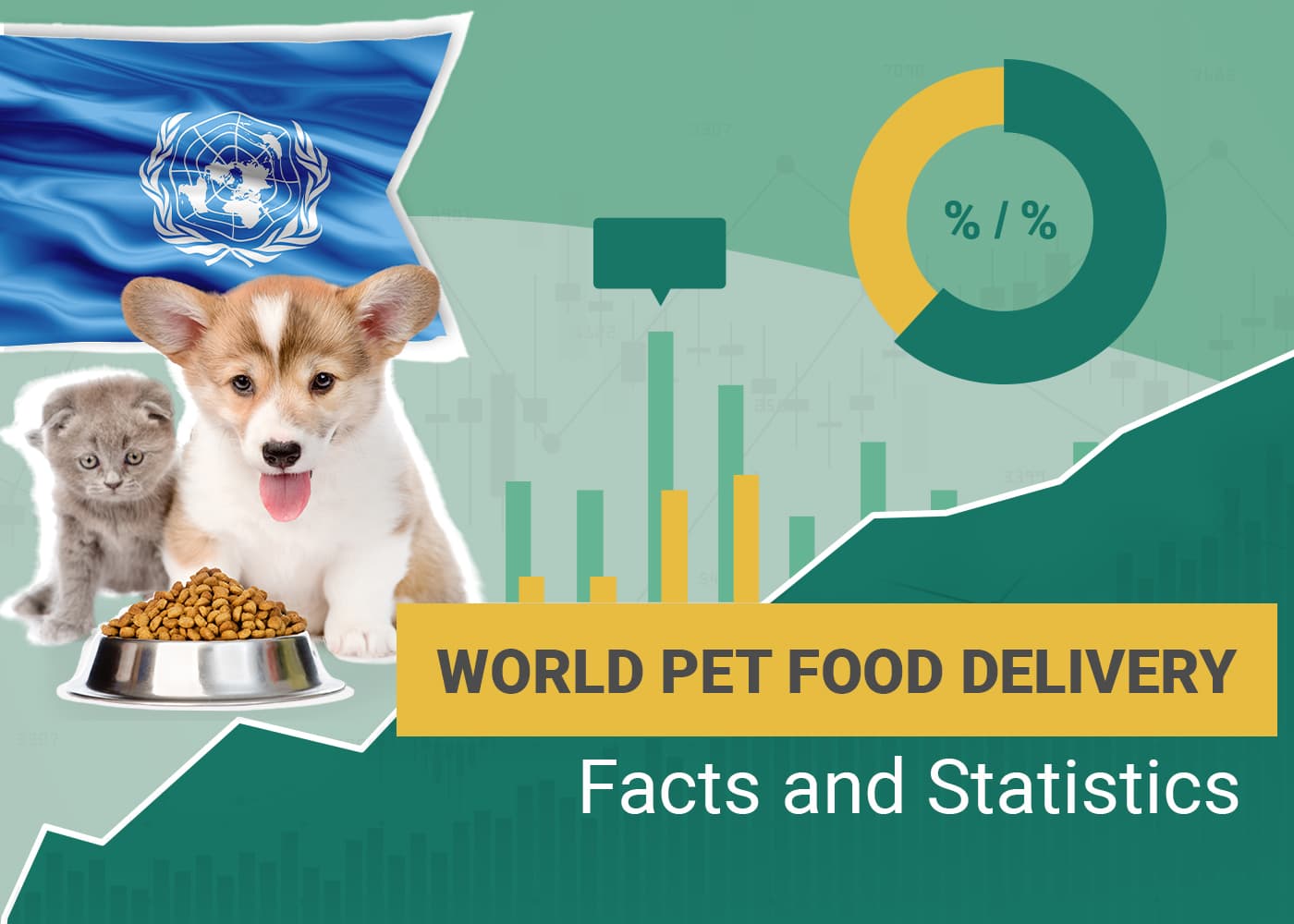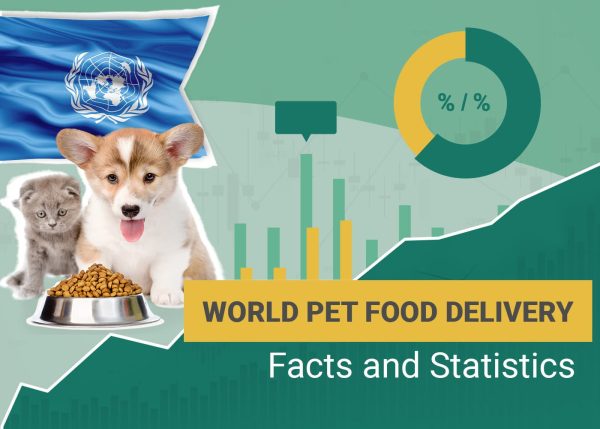Click to Skip Ahead
Pet food delivery is a vibrant and growing portion of the pet food market. More and more people are opting to buy their pet food online and have it delivered straight to their house rather than buy it in-store. These delivery services also include the growing market for pet food meal kits and fresh pet food that does not have a long shelf life. What is driving these trends? There are numerous reasons for the growth in the pet food delivery service market.
Here are 15 surprising trends and statistics about the pet food delivery service market for this year.
The 15 Pet Food Delivery Service Statistics
- Annual expenditure on household pets is expected to grow by $1,000 annually by the end of the decade.
- Animal food delivery trends are beginning to mimic human food delivery trends, including fresh offerings delivered on the same day.
- Subscription and gourmet pet food made up 16% of all pet food sales in 2021.
- The number of pets owned in developed nations has increased by 9% in recent years.
- Global pet meal kit delivery services accounted for $1.67 billion in 2020
- Global pet meal kit delivery services are expected to grow at a compound annual growth rate of 15.3% between now and 2028.
- Pet food delivery services are estimated to bring in over $5 billion in sales by 2028.
- The Asia Pacific market is projected to drive strong growth in the pet food delivery service area for the coming decade.
- Full subscription services for pet food delivery are expected to grow at a compound annual rate of 17.3%, outpacing the overall market.
- Third-party providers, like DoorDash, are reaching out to provide fast delivery services of fresh pet food from local pet stores to meet consumer demand.
- Dogs accounted for 48% of the pet food delivery service market in 2020, the largest share.
- Growth in this sector is attributed to an increased attachment to pets, a larger overall number of pets, and a more educated pet-owning population.
- Direct-to-consumer (D2C) pet food sales are expected to remain a resilient pillar of e-commerce even as other online stores begin to flag.
- Personalization of ped food orders is attractive to consumers and continues to drive strong D2C online pet food sales, including food delivery services.
- Pet lifespan and longevity can dovetail into pet food delivery subscription services and will drive the forecasted growth.
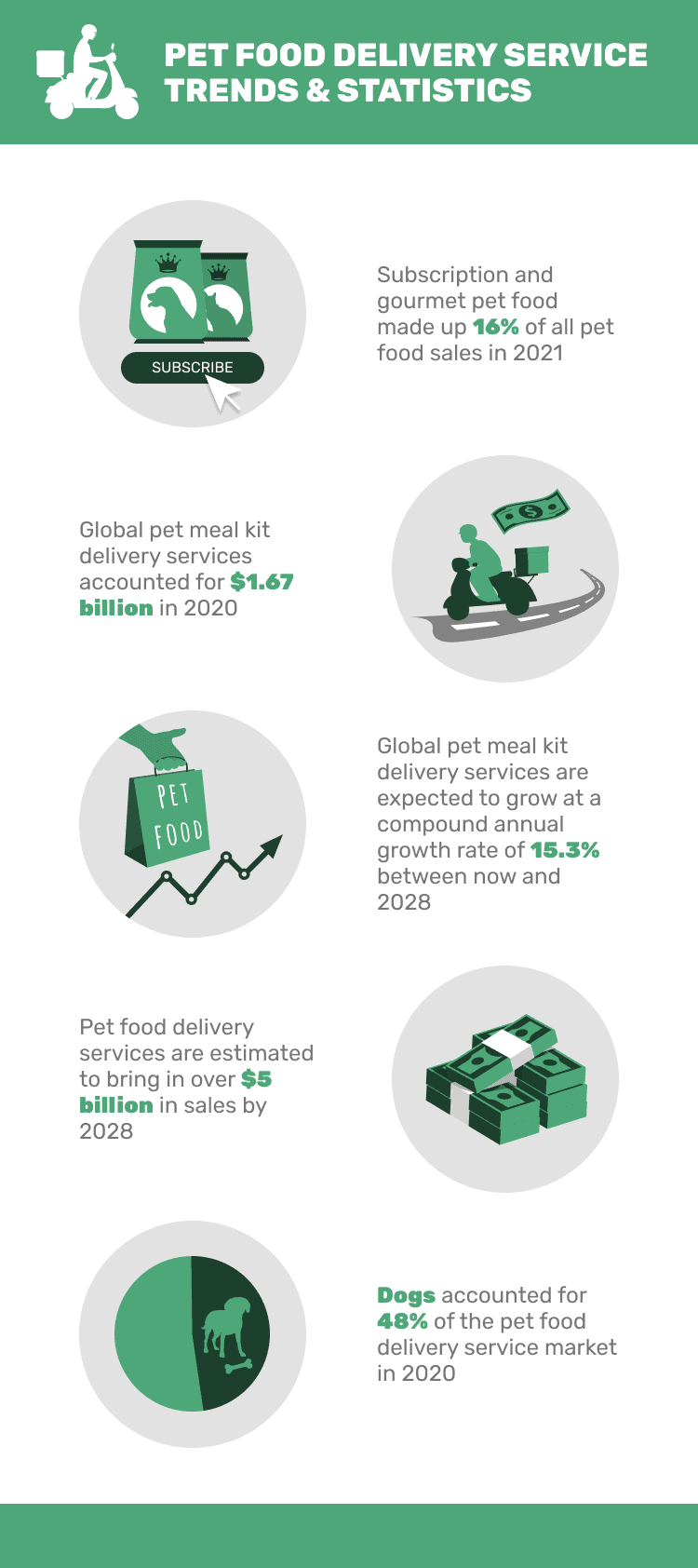
The General Pet Market
1. Annual expenditure on household pets is expected to grow by $1,000 annually by the end of the decade.
(DoorDash)
Overall expenditure on household pets is slated to double by 2030. The current average annual expenditure per pet is $900, and that number is expected to surpass $1,900 by 2030. This growth is attributed to consumers’ willingness to spend on their pets, inflation, and the prevalence of high-end items on the market. This figure includes pet food, toys, medications, and treats. This trend highlights consumers’ willingness to continue to spend more money year-over-year on their household pets.
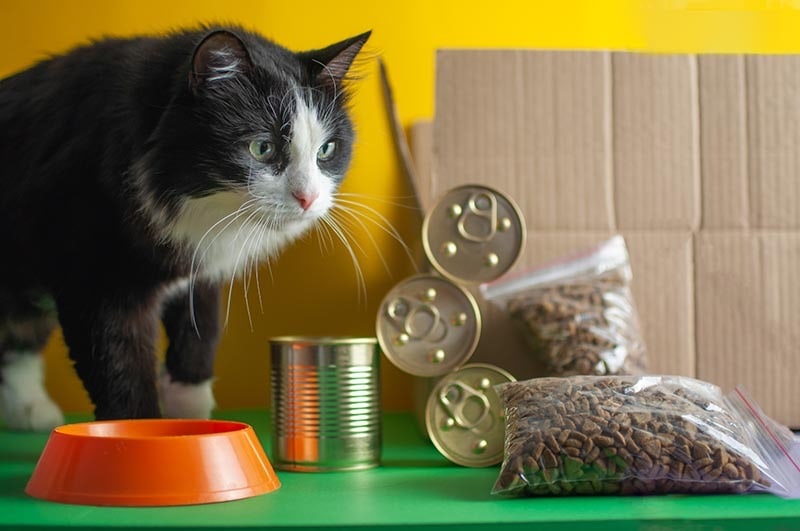
2. Animal food delivery trends are beginning to mimic human food delivery trends, including fresh offerings delivered on the same day.
(DoorDash)
Human food delivery trends have expanded to include fast food, groceries, meal kits, and more. These trends are now starting to be mimicked by the pet food delivery service industry. Experts expect the pet food delivery industry to closely mirror the human market, albeit in a delayed manner. As human delivery services expand and meal kits become more popular, so too will similar trends emerge for the pet food market.
3. Subscription and gourmet pet food made up 16% of all pet food sales in 2021.
(Statista)
In 2021, subscription and gourmet pet foods made up 16% of the overall pet food market. This represented the third largest category of pet food sales, but that market share is expected to grow as the market grows in the coming years.
4. The number of pets owned in developed nations has increased by 9% in recent years.
(Grandview Research)
A lot of the growth in this sector and the emerging trends can be attributed to the larger overall number of pets in the world today. The COVID-19 pandemic drove a lot of growth in the total number of pet-owning households. The number of households that own dogs now exceeds 65 million, while the number of households that own cats exceeded 45 million in 2021. As the number of pets increases, so too does the amount of money spent in the pet industry.

 Pet Food Delivery Service Trends for This Decade
Pet Food Delivery Service Trends for This Decade
5. Global pet meal kit delivery services accounted for $1.67 billion in 2020.
(Grandview Research)
The total amount of money spent on pet meal kit delivery services worldwide surpassed $1.5 billion for the first time in 2020. This marks a steady observable increase in this market over time. The total number of overall sales of pet food delivery is slated to continue to rise. The United States is not the only country participating in this market. Other large nations like India and Japan are also contributing to the overall global market.
6. Global pet meal kit delivery services are expected to grow at a compound annual growth rate of 15.3% between now and 2028.
(Grandview Research)
The growth in the pet food meal kit delivery market is extremely healthy. A 15% growth rate far exceeds the growth rate of the total overall economy. The gross domestic product (GDP) in the United States is growing sluggishly. Even China, one of the world’s fastest growing economies, rarely has growth that surpasses 10%. That means that the pet food delivery service industry is slated to grow at a much faster rate than other industries.
7. Pet food delivery services are estimated to bring in over $5 billion in sales by 2028.
(PR News Wire)
With a 15% growth rate, the industry is slated to surpass $5 billion in sales by 2028 and could reach $9 billion by 2030. That marks a sizable increase from the 2020 numbers and represents experts’ belief that the current trends in the pet food market are slated to continue with little disruption or interruption.
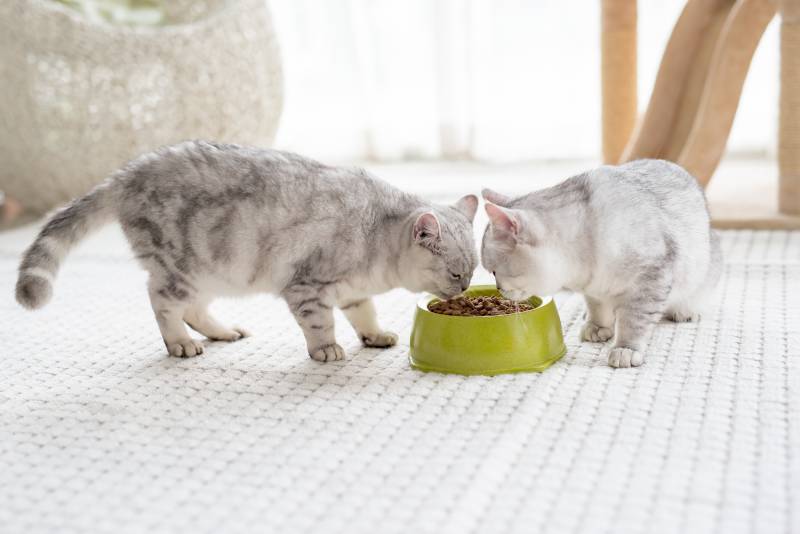
8. The Asia Pacific market is projected to drive strong growth in the pet food delivery service area for the coming decade.
(PR News Wire)
Despite people’s instinct to want to point to the United States as a growth leader in this market, the Asia Pacific region is actually expected to see the highest rate of growth in the coming decade. Nations like India, China, and Japan also have a growing number of domestic pets and are showing a similar willingness to continue to spend more money on their pets as time goes on. Pet food delivery services are not just a North American or European phenomenon. It is a global one.
9. Full subscription services for pet food delivery are expected to grow at a compound annual rate of 17.3%, outpacing the overall market.
(PR News Wire)
Full subscription services in the pet food delivery market are expected to outpace the overall growth in the industry. Full subscription services include a monthly repeating delivery of meal kits or pet food. These services are set up to be repeatable and on autopay rather than requiring consistent individual purchases. This growth shows that people are hungry for a subscription service for pet food that increases convenience and personalization.
10. Third-party providers, like DoorDash, are reaching out to provide fast delivery services of fresh pet food from local pet stores to meet consumer demand.
(DoorDash)
To fulfill the demand for consistent subscription pet food delivery services, companies like DoorDash, Shopify, and Uber Eats are reaching out to local pet stores to provide delivery services. DoorDash suggests that pet store owners could benefit from offering same-day delivery of fresh pet food via local third-party services. That can help brick-and-mortar pet store owners keep up with the growth of e-commerce outfits that provide similar services.
Who Is Using Pet Food Delivery Services?
(Global Newswire)
The pet food delivery service is made up of multiple sectors, including dogs, cats, reptiles, birds, and fish. Dogs accounted for the largest market share, taking just under half of all pet food delivery sales in 2020. The second largest sector was cats. However, people are buying pet food delivery for their birds and fish as well.
12. Growth in this sector is attributed to an increased attachment to pets, a larger overall number of pets, and a more educated pet-owning population.
(Global Newswire)
As pet owners become more attached to their pets, they are more willing to spend on services like pet food delivery. Pets are increasingly becoming more like parts of the family rather than living property. As pet owners become more invested, more educated, and more equipped in the 21st century, their appetite for spending has increased accordingly. Pet owners are more concerned with their pet’s nutrition, well-being, and health than ever before, which benefits the pet food delivery industry.
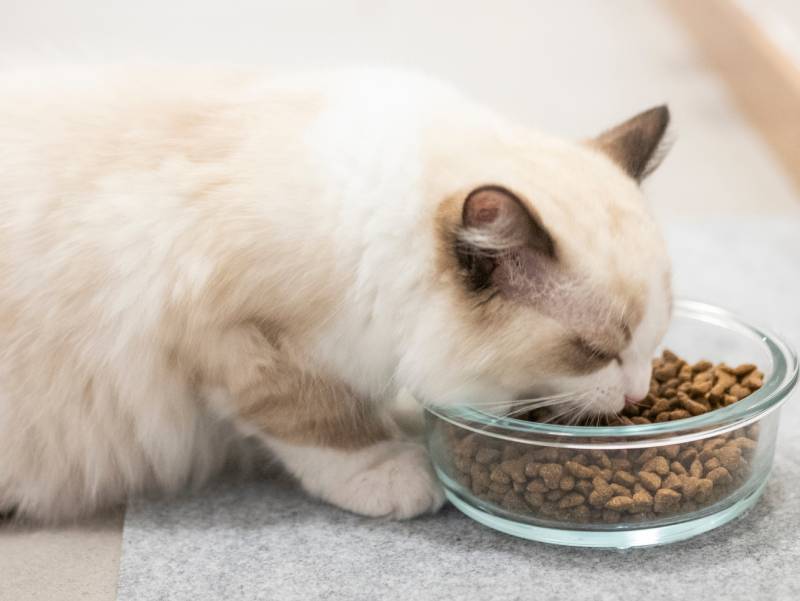
 How Pet Food Delivery Services Fit into the Overall 21st Century Economy
How Pet Food Delivery Services Fit into the Overall 21st Century Economy
13. Direct-to-consumer (D2C) pet food sales are expected to remain a resilient pillar of e-commerce even as other online stores begin to flag.
(Just-Food)
Despite a strong showing from 2000 until 2021, e-commerce is starting to slump. 2022 saw some of the worst losses in tech stocks in history, and that was driven by a slowing in the e-commerce market. Companies like Amazon lost billions in market cap valuation due to a dip in stock prices. Despite those overall market trends, pet food delivery is expected to remain strong, especially in the e-commerce space. If pet food delivery mirrors human food delivery, it could see a slump in the future, but that is yet to be seen.
14. Personalization of pet food orders is attractive to consumers and continues to drive strong D2C online pet food sales, including food delivery services.
(Just-Food)
Online pet food sales are investing in personalization to obtain and retain customers. Instead of buying generic dog food, pet food delivery services are advertising customizable food orders that focus on specific breeds, health problems, weights, and lifestyles. This allows people to get dog food that is perfect for their individual pet without having to go to the pet store to do it. That personalization is attributed to strong direct-to-consumer sales in the pet food delivery market.
15. Pet lifespan and longevity can dovetail into pet food delivery subscription services and will drive the forecasted growth.
(Just-Food)
One of the reasons that pet food delivery sales are projected to continue to grow at such a healthy rate is tied to the longevity of the average pet. If an online retailer can get a pet owner plugged into their subscription services, they could potentially have a customer for eight, nine, ten, or more years. Pets can easily live for a decade or more, and if a pet lives longer and a customer is happy with their service, it can create a long-lasting consumer partnership that will drive consistent sales for years to come.

Frequently Asked Questions About Pet Food Delivery Services
Why Are Pet Food Delivery Services Expected to Grow?
There are a number of overlapping factors driving growth in the pet food delivery industry. However, there is no single factor that dominates the rest. The growth is derived from a larger overall number of pets, families becoming more invested in their pets, the overall education level of pet owners, and the number of healthy pet foods available on the market. As owners become more educated, they tend to look into more expensive products for their pet that focuses on health and well-being. The focus on pet health makes them a more valuable part of the family. All of these things play into one another and are driving strong growth in this sector.
What Is the Most Common Type of Pet Food Purchased?
Despite the rapid growth of the pet food delivery market, the most commonly purchased pet food is still dry food that is bought in person. Market experts claim that there is little benefit to purchasing dry food in person and as the availability of pet food delivery continues to expand, pet owners will be more likely to buy online. The convenience of online buying generally outweighs the minimal benefits of buying in person. However, in-person sales of dry food continue to be the most common type of pet food purchase in the United States.
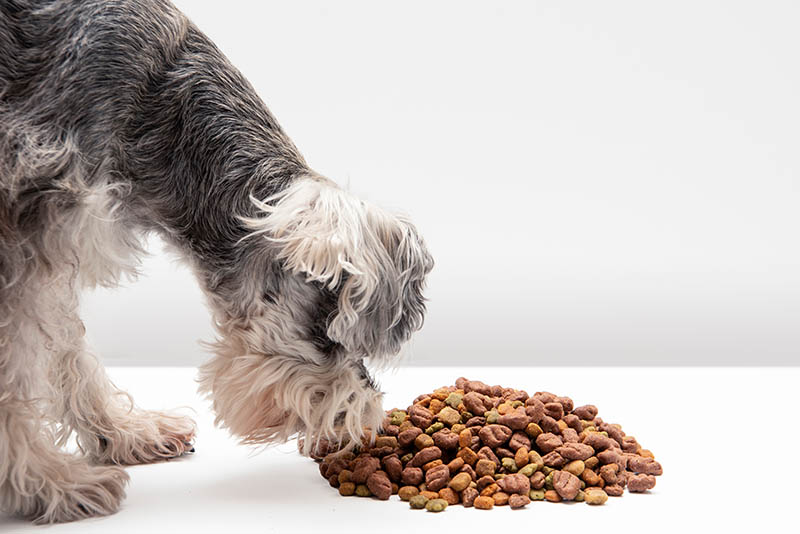
What Are the Primary Benefits of Pet Food Delivery Services?
There are two main benefits of pet food delivery services. First, it provides a lot of conveniences. As we mentioned, experts do not see a lot of benefits in buying pet food in person. Unless you are getting sales help or receiving samples of pet food, online provides all of the same benefits without having to haul dozens of pounds of heavy food from the store to your car and from your car to your home. The second benefit is personalization and customization. Orders can be tailored to a specific pet and then set up to auto-ship at regular intervals. That saves a trip to the store and ensures that you are getting the best food for your individual pet.
Conclusion
Pet food delivery services are a large and growing part of the overall pet food market. Pet meal kits, convenience services, and subscriptions are driving growth in this field. Pet food delivery services offer a lot in the way of convenience and customization that is appealing to customers. These trends are closely mirroring the same trends seen in human food delivery services, and growth is projected to be strong through 2030 at the minimum.
- See Also: Does Uber Allow Cats? Company Info
Featured Image credit: sophiecat, Shutterstock

